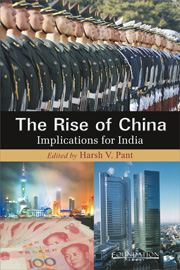10 - China in South Asia: A Tightening Embrace
from Part III - China's India Policy
Published online by Cambridge University Press: 05 June 2012
Summary
New Delhi has long viewed South Asia as India's exclusive sphere of influence and has sought to prevent the intervention of external powers in the affairs of the region. The notion of a Monroe Doctrine similar to the one proclaimed for the Western Hemisphere by the United States (US) in the nineteenth century was explored by Jawaharlal Nehru, India's first Prime Minister. Henceforth, the security of its neighbouring states was considered to be intricately linked with India's own security. With India's rise in the global interstate hierarchy in recent years, tensions have emerged between India's purported role on the world stage and demands of the challenges it faces in its own neighbourhood. South Asia is a difficult neighbourhood and India's strategic periphery continues to witness continuous turmoil and uncertainty. The instability in Pakistan, Afghanistan, Bangladesh, Nepal, Sri Lanka and Myanmar is a major inhibiting factor for India to realise its dream of becoming a major global player. India's attempts to emerge as a global economic power is marred by the uncertainty in the region and this has even stalled India's attempts at building inter-dependencies and enhancing connectivity. India is surrounded by several weak states that view New Delhi's hegemonic status in the region with suspicion. The conundrum India faces is that – while it is seen as unresponsive to the concerns of its neighbours – any diplomatic aggressiveness on its part is also viewed with suspicion and oft en resentment.
- Type
- Chapter
- Information
- The Rise of ChinaImplications for India, pp. 233 - 256Publisher: Foundation BooksPrint publication year: 2012



